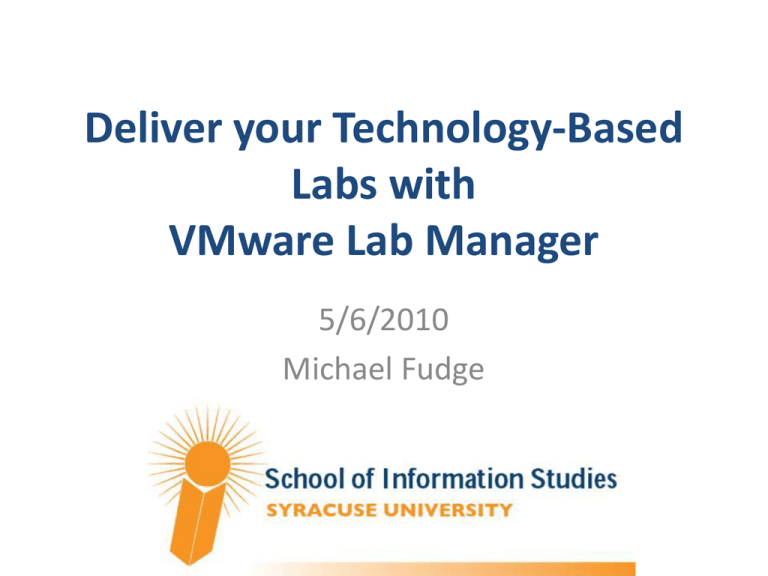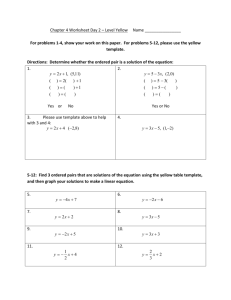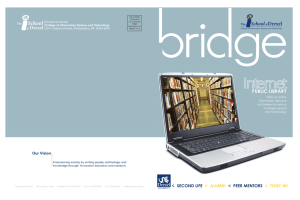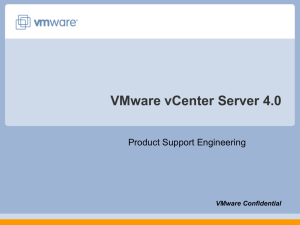Michael Fudge - This is a server for Web sites created by students at
advertisement

Deliver your Technology-Based Labs with VMware Lab Manager 5/6/2010 Michael Fudge Agenda Why is this so difficult? How lab manger makes it easer The iSchool specfic Setup Demos / Use-cases Where do we go from here? How do you conduct labs for: Operating Systems Install / Configuration Setting up and securing network services: DHCP, DNS, HTTP, SMTP, LDAP, Etc… Host and network-based firewalls. Routing, NAT, VLANS. Application deployment, workstation configurations. Advanced services: web applications, email, VOIP A Typical Example: “The Email Lab” • You’d like build an experiential learning activity around email and its protocols • From a configuration standpoint, you’d like each student to have the same experience. Email Client: Windows XP •Outlook Express •Wireshark Email Server: Windows 2003 •hMailServer How it used to be done. Need a lot of hardware to Ethernet Switch Windows XP client Windows 2003 email server do this for the entire class. Need a lot of space for the hardware Difficult to prepare and deploy labs in this manner, and keep them consistent. Students must be “in the lab” to complete the exercise. Platform Virtualization makes things a little better Platform Virtualization • VMware workstation • Virtual Box • Virtual PC What used to be a computer is now just “files” The “host” computer is a lab workstation or student’s personal computer. Requires several GB of storage. Where do you put all those the files? Where Do You Store Your Platform VM files? “Mobile Racks” Students must sit at same seat in lab High failure rate from adding / removing drives “Portable Storage” Poor I/O performance Deployment issues – how do you get the VM files to the students? “File Server” Need high network bandwidth to server File server becomes a bottleneck under high utilization The Lab Manager Solution… Accessible through a web browser “Package-able” Provides network isolation Consistent configurations Accessible anytime from anywhere What Exactly is Lab Manager? “Web browser-based delivery of platform virtual machines and networks.” Think: Overview of Lab Manager Let’s take a quick look https://vlab.ischool.syr.edu Configuration: The core concept Virtual Machines Virtual Networks Physical Network Configuration Boundary Security Model Lab Manager iSchool Implementation Organization iSchoolLabs iSchoolLabs iSchoolLabs Main Workspaces Users and Groups assigned to organizations / workspaces then given permission to resources (Configurations and Templates). Staging Course Specific To confine a set of resources to a group of users, (for a specific course or research project, for example) a separate workspace must be created iSchool Physical Network Implementation SU Network 128.230.x.y Vyatta NAT 10.1.1.1 Lab Manager VM’s 10.1.2.2 through 10.1.254.254 Lab Manager VM’s The NAT removes the requirement of each VM having an IP address on the Campus Network, and the MAC address registered to the IP. Virtual Networks can leverage the physical network as needed iSchool Roles/Workflow Security Management Lab Designers VM Template(s) Template Designers Administrators Workspace Management Configuration Network Template(s) Students & Teachers Clone from Library to Workspace Create VM Template(s) Create Network Template(s) Library Archive Library Capture Deploy Configuration (Powers on VM’s) Connect Virtual And Physical Networks Lab Designers: Steps to deploy a Configuration Add VM / Network Templates to Configuration Deploy the configuration to test it Capture to library when ready and share with others Tweak / make changes as necessary Lab Designers can practice these step in a special organization called “iSandbox” Demo Time! https://vlab.ischool.syr.edu Software Costs Costs are negligible thanks to: Vendor “Academic Initiatives” (IBM, Microsoft). Low-cost operating systems, flexible licensing Vyatta (open source cisco-like networking) Vmware e-acadamy $150 /year licensed to support ESX, vCenter and Lab Manager Hardware required: SAN (iSCSI / FC) Servers ESX Hosts vCenter Lab Manager Lab Manager vCenter ESX1 ESX2 SAN … ESXn Estimates for ESX Hosts (no SAN) Count of Concurrent Class Sections (n=32) Approximate Cost 2 Dell Power edge Servers 1 $11,500 2 $21,000 3 $27,500 4 $34,000 6 $48,800 2 Server minimum Recommended Count in class section = 32 (30 students 1 TA, 1 Prof) Estimate based on 64GB RAM required to run one class section Agreement to leverage SAN @ Central IT, so there’s a substantial cost savings there. Next Steps for us Build “iSandbox” for template designers to hone their craft. Identify which classes should be moved into this environment first (for Fall 2010). Class Roster Integration – Powershell Cmdlet. Purchase hardware to support real use in the classroom. Start rebuilding labs for the new environment over the summer. Most importantly: Capture pilot experiences for best practices. Thank you - Questions? http://michaelfudge.com/lab-manager Or http://bit.ly/fudgelabman











